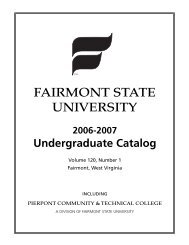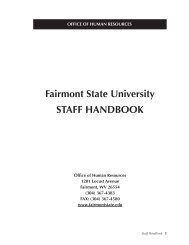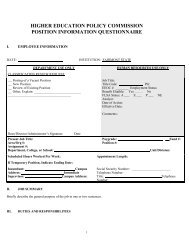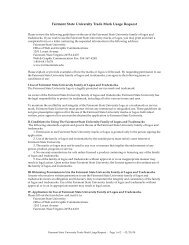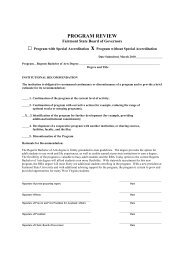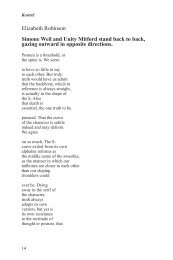Faculty Handbook - Fairmont State University
Faculty Handbook - Fairmont State University
Faculty Handbook - Fairmont State University
Create successful ePaper yourself
Turn your PDF publications into a flip-book with our unique Google optimized e-Paper software.
104<br />
3.1.3. Each student shall have access to a copy of the <strong>University</strong> catalog or<br />
program brochure in which current academic program requirements<br />
are described (e.g., required courses, total credit requirements,<br />
minimum grade point average, probation standards, professional<br />
standards, etc.). Students have the right to receive from the instructor<br />
written descriptions of content and requirements for any course in<br />
which they are enrolled (e.g., attendance expectations, special<br />
requirements, laboratory requirements including time, field trips and<br />
costs, grading standards and procedures, professional standards, etc.).<br />
3.1.4. The instructor of each course is responsible for assigning grades to<br />
students enrolled in the course, consistent with the academic rights set<br />
out in the preceding sections.<br />
SECTION 4. APPLICATION OF POLICY TO STUDENTS<br />
4.1. Student: any person who has been admitted to the institution to pursue a course<br />
of study, research, or service, who is currently engaged in an institutionally<br />
sponsored activity, and who has some right or privilege to be on the campus or<br />
in the facilities of the institution, or to use the same, in connection with study,<br />
research, or service, or who yet has some right or privilege to receive some<br />
benefit or recognition or certification from the institution, under the rules or<br />
procedures of the institutions.<br />
4.2. A student, as defined in this rule, shall be subject to any applicable penalties for<br />
failure to comply with the academic requirements and standards promulgated<br />
by the institution according to Section 2.1 of this rule. Students are expected to<br />
adhere to these academic standards in all academic settings, classrooms,<br />
laboratories, clinics and any other activities which are part of academic<br />
requirements.<br />
SECTION 5. ACADEMIC REQUIREMENTS AND CONSEQUENCES OF FAILURE TO MEET<br />
REQUIREMENTS<br />
5.1. The president or designee shall define and promulgate the academic<br />
requirements, criteria and standards as set out in Section 2.1 of this rule.<br />
Normally, students may finish a program of study according to the requirements<br />
under which they were admitted to the program. However, requirements are<br />
subject to change at any time, with reasonable notice provided to the students.<br />
5.2. A student who fails to meet the academic requirements or standards, including<br />
those for academic honesty as defined by the institution according to Section 2.1<br />
of this rule, may be subject to one or more of the following penalties:<br />
5.2.1. A lower grade or failure of the course or exclusion from further<br />
participation in the class (including laboratories or clinical experiences),<br />
all of which may be imposed by the instructor.<br />
5.2.2. Academic probation as determined and defined by the institution.<br />
5.2.3. Academic suspension as determined and defined by the institution.<br />
5.3. Academic dismissal is defined as termination of student status, including any<br />
right or privilege to receive some benefit or recognition or certification. A<br />
student may be academically dismissed from a limited enrollment program and<br />
remain eligible to enroll in courses in other programs at the institution, or a



